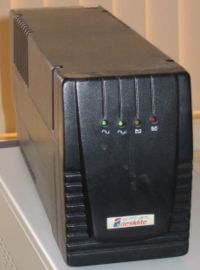
Photo from wikipedia
The eco-mode provides a high-efficiency operation for the double-conversion uninterrupted power supplies (UPSs). Such a mechanism utilizes the solid-state transfer switch (STS) path to power the susceptible loads, and it… Click to show full abstract
The eco-mode provides a high-efficiency operation for the double-conversion uninterrupted power supplies (UPSs). Such a mechanism utilizes the solid-state transfer switch (STS) path to power the susceptible loads, and it relies on the converter as an alternate resource when the abnormal grid occurs. The thyristor-based STS system has the advantage of low conduction loss, but the natural commutation often prolongs the overall transfer process. Consequently, the susceptible loads suffer from severe grid faults for a long time. This article investigates the commutation mechanism between the thyristor-based STS system and the double-conversion UPS. A forced commutation control is presented to accelerate the transfer process through the back-to-back neutral-point clamped (BTBNPC) converter. Besides, the waveform qualities and the dynamics of both ac and dc ends are considered for the BTBNPC converter. Finally, the laboratory test results are provided to validate the effectiveness of the proposed approach.
Journal Title: IEEE Transactions on Industry Applications
Year Published: 2020
Link to full text (if available)
Share on Social Media: Sign Up to like & get
recommendations!